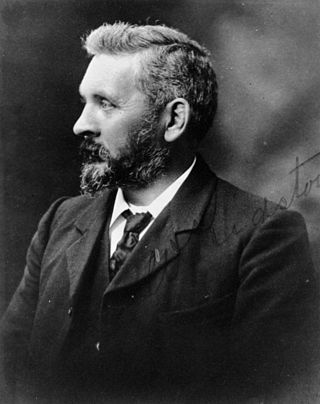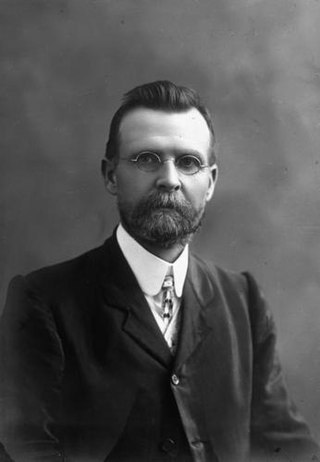Related Research Articles

Frederic John Napier Thesiger, 1st Viscount Chelmsford, was a British statesman. He served as Governor of Queensland from 1905 to 1909, Governor of New South Wales from 1909 to 1913, and Viceroy of India from 1916 to 1921, where he was responsible for the creation of the Montagu–Chelmsford Reforms. After serving a short time as First Lord of the Admiralty in the government of Ramsay MacDonald, he was appointed the Agent-General for New South Wales by the government of Jack Lang before his retirement.

Sir Robert Philp, was a Queensland businessman and politician who was Premier of Queensland from December 1899 to September 1903 and again from November 1907 to February 1908.

William Kidston was an Australian bookseller, politician and Premier of Queensland, from January 1906 to November 1907 and again from February 1908 to February 1911.

Digby Frank Denham was a politician and businessman in Queensland, Australia. He was a Premier of Queensland and Member of the Queensland Legislative Assembly. He was the first of only two Queensland Premiers to lose their own seat at a general election.
This is a list of members of the 15th Legislative Assembly of Queensland from 1904 to 1907, as elected at the 1904 state election held on 27 August 1904.
This is a list of members of the 16th Legislative Assembly of Queensland from May 1907 to February 1908, as elected at the 1907 state election held on 18 May 1907.
This is a list of members of the 17th Legislative Assembly of Queensland from February 1908 to October 1909, as elected at the 1908 state election held on 5 February 1908.
The Denham Ministry was the 26th ministry of the Government of Queensland and was led by Premier Digby Denham, who led the Ministerialist party consisting of a mixture of liberals and conservatives. It succeeded the Kidston Ministry on 7 February 1911. The ministry was followed by the Ryan Ministry on 1 June 1915 after the government was defeated by the Labor Party at the 1915 state election on 22 May, at which several of the ministers including Denham himself lost their seats.
The Second Kidston Ministry was the 25th ministry of the Government of Queensland and was led by Premier William Kidston. It succeeded the Second Philp Ministry on 18 February 1908, 13 days after the 1908 state election. The ministry was followed by the Denham Ministry on 7 February 1911 following Kidston's retirement from politics.
The First Kidston Ministry was the 23rd ministry of the Government of Queensland and was led by Premier William Kidston, who led a Labour–Liberal coalition. It succeeded the Morgan ministry on 19 January 1906 upon the appointment of Arthur Morgan as president of the Queensland Legislative Council. The Labour Party split in 1907, with Kidston and several other moderate Labour members combining with the remaining Liberals in a new party, the "Kidstonites".
The Ryan Ministry was the 27th ministry of the Government of Queensland and was led by Premier T. J. Ryan of the Labor Party. It was the first majority Labor government in Queensland's history. It succeeded the Denham Ministry on 1 June 1915, following the latter's defeat at the 1915 state election on 22 May. It was succeeded by the Theodore Ministry on 22 October 1919 following T. J. Ryan's resignation from the Queensland parliament to run for federal politics.
The Theodore Ministry was the 28th ministry of the Government of Queensland and was led by Premier Ted Theodore of the Labor Party. It succeeded the Ryan Ministry on 22 October 1919 following T. J. Ryan's resignation from the Queensland parliament to run for federal politics, and was in turn succeeded by the Gillies Ministry on 26 February 1925 when Theodore followed his predecessor into federal politics.

Elections were held in the Australian state of Queensland on 18 May 1907 to elect the 72 members of the state's Legislative Assembly. The election was the first one in which women had a right to vote.

Elections were held in the Australian state of Queensland on 5 February 1908 to elect the 72 members of the state's Legislative Assembly. The election, held less than 9 months after the previous election, was made necessary by a series of events which had seen former Premier William Kidston, who commanded a majority on the floor of the Assembly, resign following an attempt to convince the Governor of Queensland to appoint sympathetic members to the Queensland Legislative Council, which had blocked key legislative measures. Following Kidston's resignation, Opposition leader Robert Philp was sent for and formed a ministry, but the ministry almost immediately lost a vote of no confidence in the Assembly, and as such, a new election had to be called.
The Morgan Ministry was the 22nd ministry of the Government of Queensland and was led by Premier Arthur Morgan, who led a Liberal–Labour coalition.

Elections were held in the Australian state of Queensland on 17 May 1969 to elect the 78 members of the Legislative Assembly of Queensland.

Walter Henry Barnes was a longtime member of the Queensland Legislative Assembly.
The Kidstonites or Kidston party were a political party in the Australian state of Queensland in 1907 to 1908, formed by William Kidston. The party resulted from a split in the Queensland Labor Party and spent most of its existence in government, before merging with the conservative faction of Robert Philp in October 1908, to form the Liberal Party.
The Liberal Party was a political party in the Australian state of Queensland in the early 20th century. It combined the main non-Labor forces, the "Kidstonites" of William Kidston and the Conservatives of Robert Philp, similar to the federal Commonwealth Liberal Party whose fusion it preceded. The Liberals held government from their formation in 1908 until defeat in 1915 after which they combined with other elements in the state to form the National Party.

The Bjelke-Petersen Ministry was a ministry of the Government of Queensland and was led by Premier Joh Bjelke-Petersen, who led the Country Party and its successor, the National Party. It succeeded the Chalk Ministry on 8 August 1968 as part of a series of events following the death of former Premier Jack Pizzey on 31 July. It was succeeded by the Ahern Ministry on 1 December 1987 following Bjelke-Petersen's resignation as Premier.
References
- "Proclamation". Queensland Government Gazette . 19 November 1907. p. 89:1265–1267.
- "Proclamation". Queensland Government Gazette . 18 February 1908. p. 90:455–457.
- Hughes, Colin A.; Graham, B. D. (1968). A handbook of Australian government and politics, 1890-1964. Canberra: Australian National University. p. 173. ISBN 0-7081-0270-0.